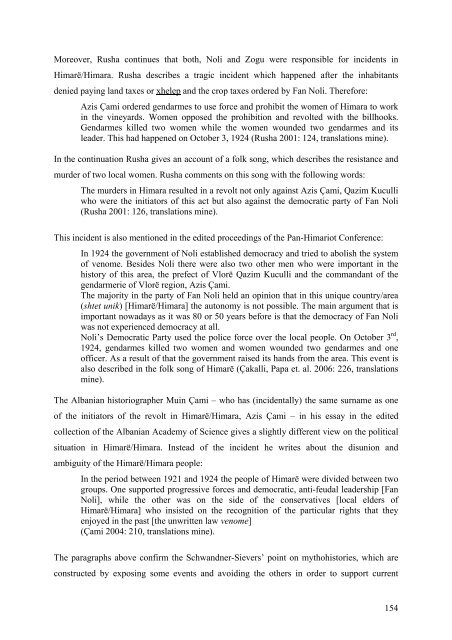university of nova gorica graduate school contested spaces and ...
university of nova gorica graduate school contested spaces and ...
university of nova gorica graduate school contested spaces and ...
You also want an ePaper? Increase the reach of your titles
YUMPU automatically turns print PDFs into web optimized ePapers that Google loves.
Moreover, Rusha continues that both, Noli <strong>and</strong> Zogu were responsible for incidents in<br />
Himarë/Himara. Rusha describes a tragic incident which happened after the inhabitants<br />
denied paying l<strong>and</strong> taxes or xhelep <strong>and</strong> the crop taxes ordered by Fan Noli. Therefore:<br />
Azis Çami ordered gendarmes to use force <strong>and</strong> prohibit the women <strong>of</strong> Himara to work<br />
in the vineyards. Women opposed the prohibition <strong>and</strong> revolted with the billhooks.<br />
Gendarmes killed two women while the women wounded two gendarmes <strong>and</strong> its<br />
leader. This had happened on October 3, 1924 (Rusha 2001: 124, translations mine).<br />
In the continuation Rusha gives an account <strong>of</strong> a folk song, which describes the resistance <strong>and</strong><br />
murder <strong>of</strong> two local women. Rusha comments on this song with the following words:<br />
The murders in Himara resulted in a revolt not only against Azis Çami, Qazim Kuculli<br />
who were the initiators <strong>of</strong> this act but also against the democratic party <strong>of</strong> Fan Noli<br />
(Rusha 2001: 126, translations mine).<br />
This incident is also mentioned in the edited proceedings <strong>of</strong> the Pan-Himariot Conference:<br />
In 1924 the government <strong>of</strong> Noli established democracy <strong>and</strong> tried to abolish the system<br />
<strong>of</strong> venome. Besides Noli there were also two other men who were important in the<br />
history <strong>of</strong> this area, the prefect <strong>of</strong> Vlorë Qazim Kuculli <strong>and</strong> the comm<strong>and</strong>ant <strong>of</strong> the<br />
gendarmerie <strong>of</strong> Vlorë region, Azis Çami.<br />
The majority in the party <strong>of</strong> Fan Noli held an opinion that in this unique country/area<br />
(shtet unik) [Himarë/Himara] the autonomy is not possible. The main argument that is<br />
important nowadays as it was 80 or 50 years before is that the democracy <strong>of</strong> Fan Noli<br />
was not experienced democracy at all.<br />
Noli’s Democratic Party used the police force over the local people. On October 3 rd ,<br />
1924, gendarmes killed two women <strong>and</strong> women wounded two gendarmes <strong>and</strong> one<br />
<strong>of</strong>ficer. As a result <strong>of</strong> that the government raised its h<strong>and</strong>s from the area. This event is<br />
also described in the folk song <strong>of</strong> Himarë (Çakalli, Papa et. al. 2006: 226, translations<br />
mine).<br />
The Albanian historiographer Muin Çami – who has (incidentally) the same surname as one<br />
<strong>of</strong> the initiators <strong>of</strong> the revolt in Himarë/Himara, Azis Çami – in his essay in the edited<br />
collection <strong>of</strong> the Albanian Academy <strong>of</strong> Science gives a slightly different view on the political<br />
situation in Himarë/Himara. Instead <strong>of</strong> the incident he writes about the disunion <strong>and</strong><br />
ambiguity <strong>of</strong> the Himarë/Himara people:<br />
In the period between 1921 <strong>and</strong> 1924 the people <strong>of</strong> Himarë were divided between two<br />
groups. One supported progressive forces <strong>and</strong> democratic, anti-feudal leadership [Fan<br />
Noli], while the other was on the side <strong>of</strong> the conservatives [local elders <strong>of</strong><br />
Himarë/Himara] who insisted on the recognition <strong>of</strong> the particular rights that they<br />
enjoyed in the past [the unwritten law venome]<br />
(Çami 2004: 210, translations mine).<br />
The paragraphs above confirm the Schw<strong>and</strong>ner-Sievers’ point on mythohistories, which are<br />
constructed by exposing some events <strong>and</strong> avoiding the others in order to support current<br />
154

















